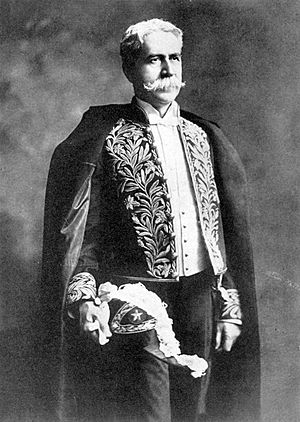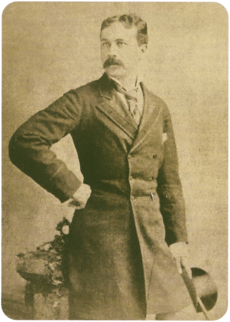Joaquim Nabuco facts for kids
Quick facts for kids
Joaquim Nabuco
|
|
|---|---|

Joaquim Nabuco at age 53, 1902.
|
|
| Born | August 19, 1849 |
| Died | January 17, 1910 (aged 60) Washington, D.C., U.S.
|
| Alma mater | Faculty of Law of Recife |
| Occupation | Diplomat and politician |
| Spouse(s) | Evelina Torres Soares Ribeiro (m. 1889) |
| Children | Maurício Joaquim Carolina Mariana José Tomas |
| Signature | |
Joaquim Aurélio Barreto Nabuco de Araújo (born August 19, 1849 – died January 17, 1910) was a famous Brazilian writer and politician. He was a very important leader in the movement to end slavery in his country.
Early Life and Learning
Joaquim Nabuco was born in Brazil. His father, Jose Thomas Nabuco, was a powerful politician in the Brazilian Empire. Jose Nabuco was a senator and a wealthy landowner. In the 1860s, he helped start the Liberal Party. He also supported changes that led to slavery being abolished in 1888.
Personal Life
Joaquim Nabuco spent several years traveling and living in other countries between 1873 and 1878. He later married Evelina Torres Soares Ribeiro when he was 38 years old. Nabuco was also a good friend of the well-known writer Machado de Assis.
Fighting for Freedom and Diplomacy
When Nabuco returned to Brazil in 1878, he started his public fight against slavery. He used his political role and his writings to speak out. He worked against slavery in the Chamber of Deputies, which is like a parliament. He also helped create the Brazilian Anti-Slavery Society.
In 1883, he wrote a very important book called O Abolicionismo. This book was a strong argument against slavery in the Portuguese language. Nabuco played a big part in ending slavery in Brazil in 1888. He believed that free workers and enslaved workers could not exist together. He also thought that slavery made it hard for new people to move to Brazil.
After Brazil became a republic and the monarchy was overthrown, Nabuco took a break from public life.
Later, from 1905 to 1910, he became the first ambassador from Brazil to the United States. This was a big step for Brazil's role in the world. Nabuco understood how important it was for Brazil and other South American countries to have a strong relationship with the United States. In Washington, D.C., he worked with Elihu Root, who also believed in this idea called Pan-Americanism. Pan-Americanism is about countries in North and South America working together.
Nabuco spent many years in England and France, where he strongly supported Pan-Americanism. He even led the Pan-Americanism conference in 1906. After Nabuco passed away on January 17, 1910, the Pan-American Building in Washington, D.C., was finished. At the building's dedication, the Secretary of State spoke about Nabuco, saying he was a "dear and noble friend" and a "commanding figure" in the movement for cooperation between American nations.
His most famous book is his autobiography, Minha formação, published in 1900. It gives a clear picture of what life was like in Brazil when slavery existed in the 1800s. Two of his main works, Minha formação and O abolicionismo, have been translated into English as My Formative Years and Abolitionism.
See also
 In Spanish: Joaquim Nabuco para niños
In Spanish: Joaquim Nabuco para niños


